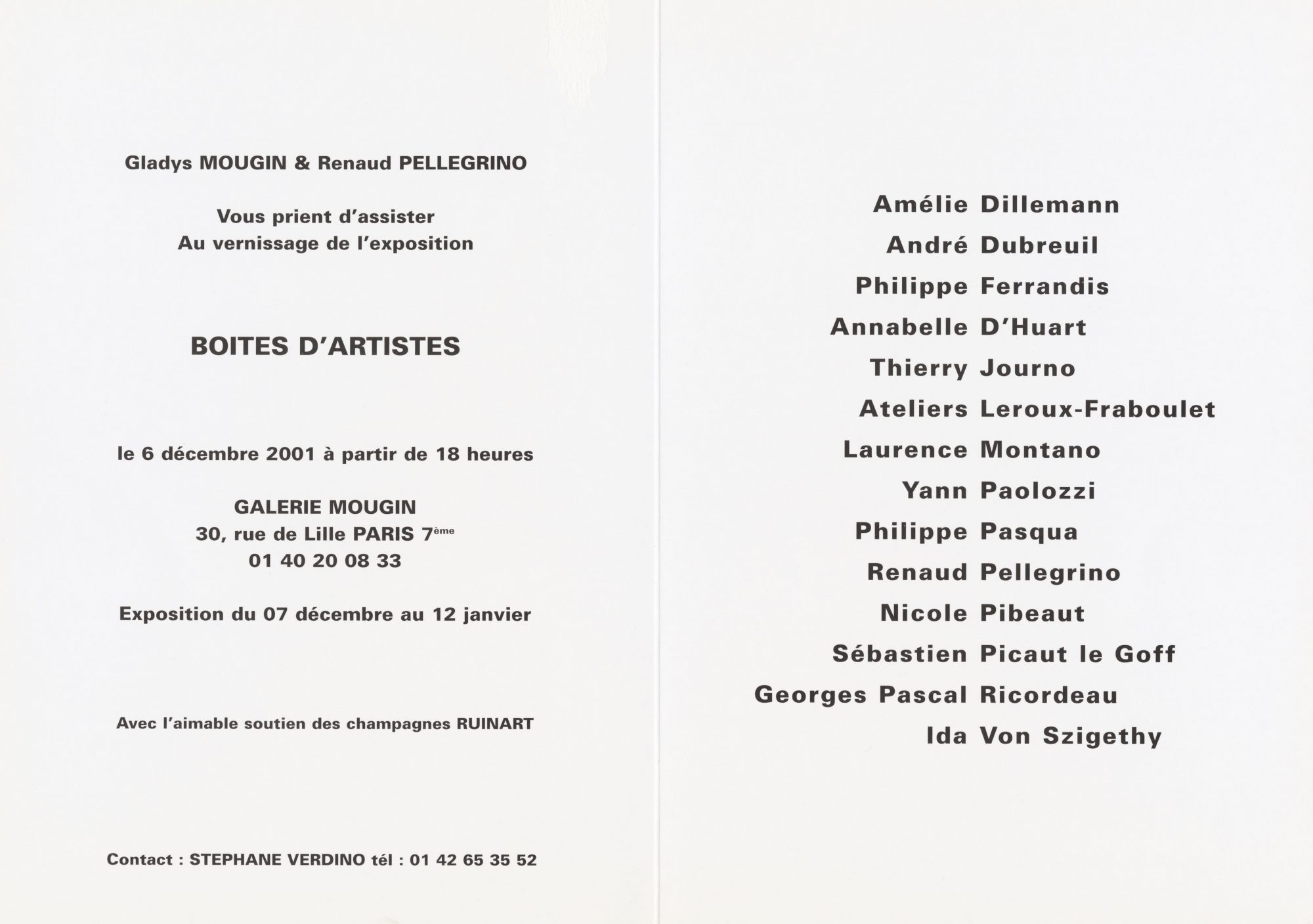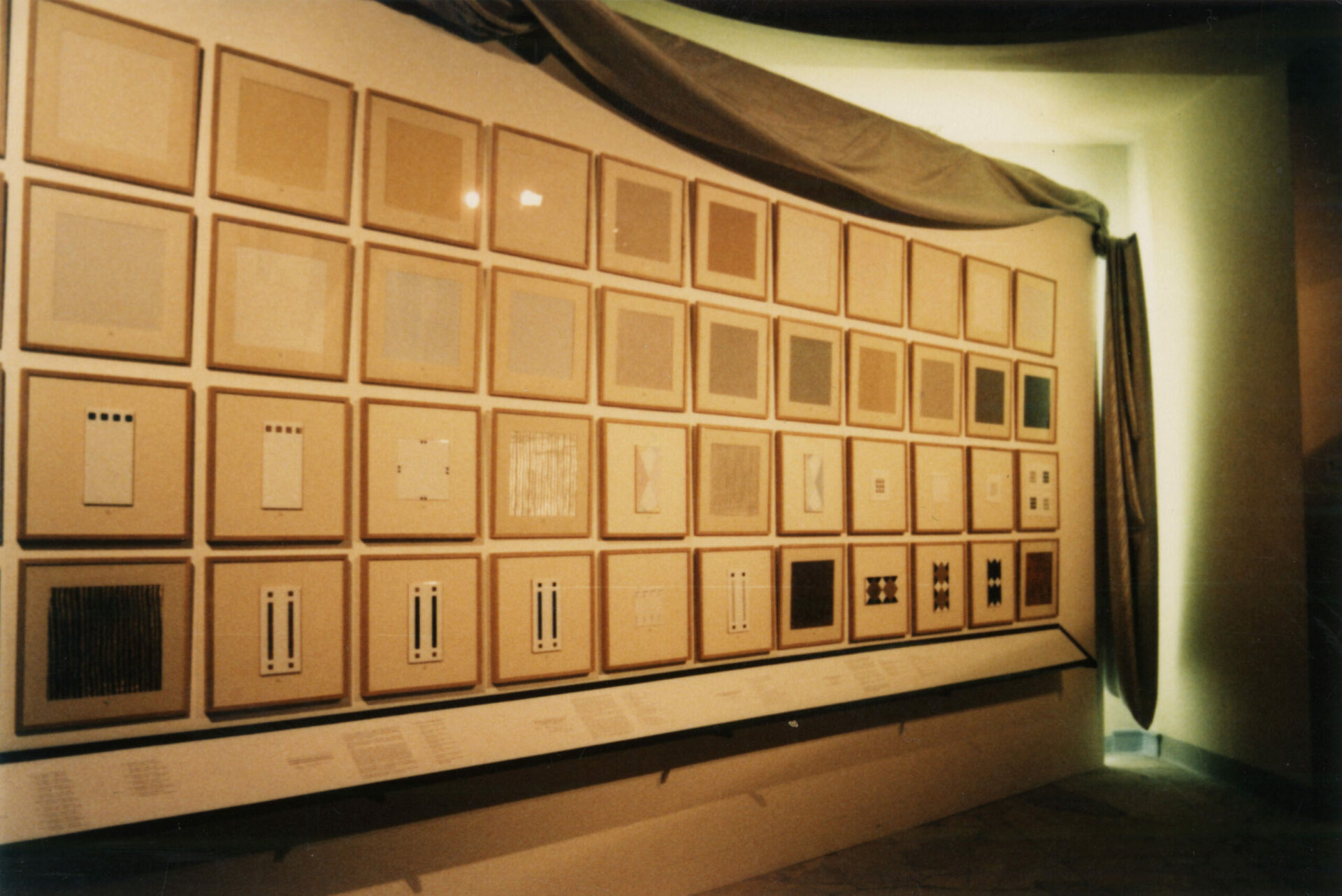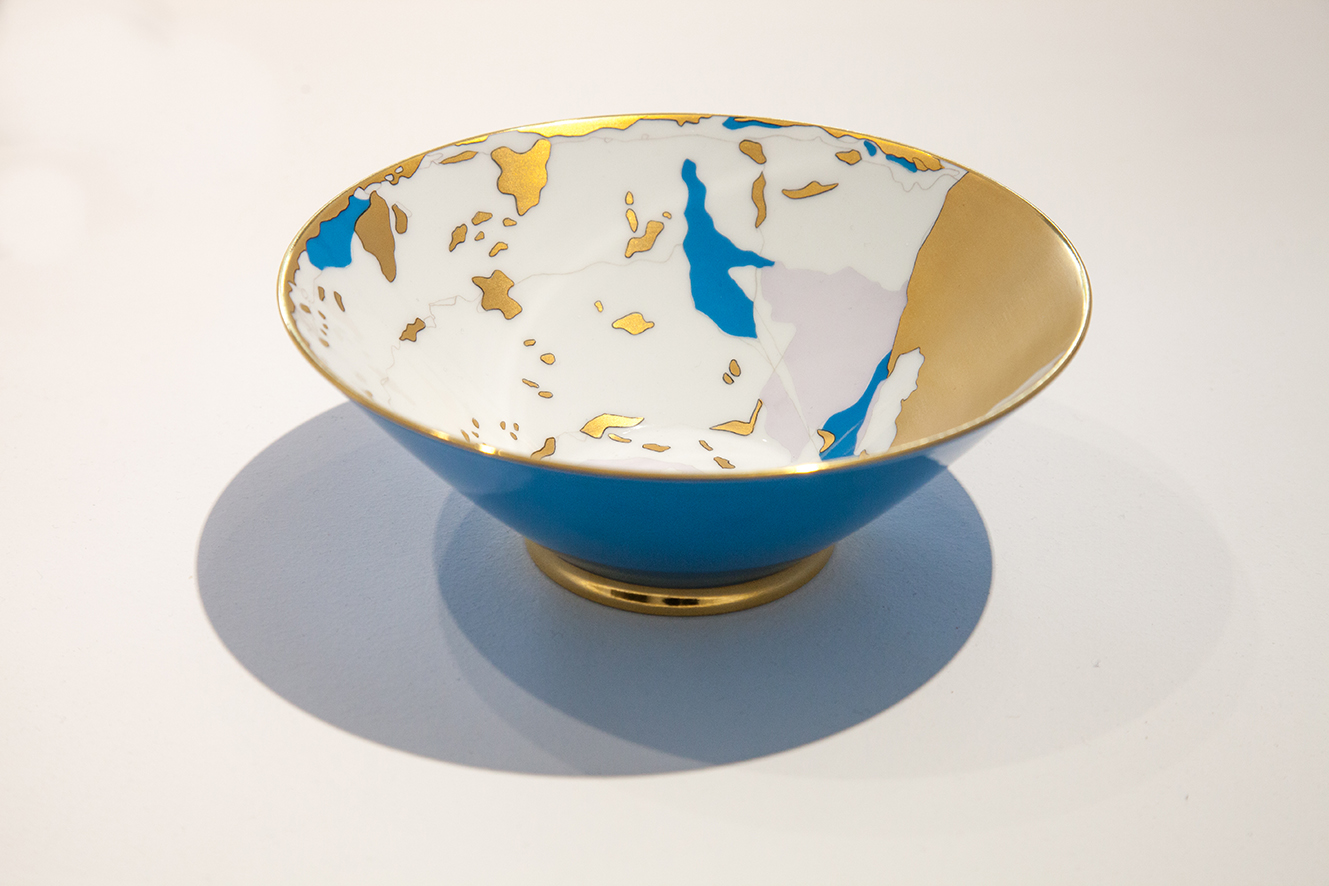1990-1992 Group show exhibitions
,
Exhibitions
1 – JOAILLERIE DE FANTAISIE, sacs-objets d’Annabelle d’Huart 1990-1992
From December 3rd to 23th 1992.
The bags, precious and poetic objects, are a homage to the capacities of Parisian handicrafts still alive at the end of the century. They are unusual objects impregnated with audacity and freedom.
Location: Galerie Révillon d’Apreval, Paris / Carolle Thibault-Pomerantz.
–
2 – MUSÉES & CRÉATIONS, co-edition Réunion des musées nationaux, Ministère de la Culture.
June to September, 1997
Three dozen unique platters in earthenware. “On each of the dishes, the figure of a circle centered like a target is wounded by a escaping flow.”
Location: Carrousel du Louvre, Paris.
–
3 – BOÎTES D’ARTISTES
Dates From December 6th 2001 to January 12th 2002
Handbag designer Renaud Pellégrino invited ten artists to reinterpret a sample clutch which culminated in an exhibition. Annabelle d’Huart’s clutch featured Fibonacci’s golden spiral in metal on satin and leather.
Location: Gladys Mougin Gallery, Paris.
–
4 – L’ARTE CONTEMPORANEA ALLA MANIFACTURA DI SÈVRES (Contemporary Art at the Manufacture of Sèvres)
From April 11th to May 21st 2000
Dinner service set for the French Embassy in Rome.
Location: French Gallery in Piazza Navona, Rome, Italy.
–
5 – BLUE
From October 20th 2005 to January 20th 2006.
A dinner set consisting of three polychrome and gold Damascus bowls placed on a metal base with a mirror top and rocaille feet in gilded bronze.
Location: Sèvres Gallery, Paris and Ceramic Contemporary Art Fair in London.
6 – ART ET INDUSTRIE
1985
Installation.
Location: Palais de Chaillot, Paris.
7 – 2000 EN FRANCE
October 12th 1999
Group show. Monnaie de Paris invited artists to create objects, medals or jewellery to celebrate the passage to the third millennium.
Inspired by La Méridiènne verte, a row of trees bisecting France from north to south, Annabelle d’Huart created jewellery collection titled La Méridienne. Each link in the necklaces, bracelets and earrings take the shape of every department the row of trees crosses.
Location: Hôtel de la Monnaie de Paris, Paris.
–
8 – CRÉATIONS CONTEMPORAINES
From June 1st to September 30th 2002.
Group-show featuring Atlantis.
Location: Manufacture Bernardaud, France.
–
9 – PIXI GALLERY: MARIE-VICTOIRE POILAKOFF
A photograph, The Cathedral, charcoal print, on Korean paper.
Pixi Gallery, Marie-Victoire Poliakoff
“A PARISIAN GALLERY IN NEW-YORK”
at Zürcher Gallery,New York.
–
10 – CÉRAMIQUES D’ARTISTES
For the Parcours Saint-Germain (A Tour of Saint Germain), a selection of jewels from the Choses de flot et de mer collection made by the Manufacture de Sèvres were put on display.
Location: Studio France Frank, Paris.
–
11 – BIJOUX DE PORCELAINE ET PLUS…
From May 7th to June 5th
Jewels from the Choses de flot et de mer collection made by the Manufacture de Sèvres.
Location: Hélène Porée Gallery, Paris.
–
12 – CRÉATION CONTEMPORAINE À LA MANUFACTURE DE SÈVRES
Group show featuring Atlantis (both the porcelain set and tapestries).
Atlantide decor, 1996, plain service. 6 different decorations (flat, dessert, cake plate, fruit bowl, 32 cm round dish, 1999 edition. Tea service, coffee service, sugar bowl, etc.).
Location: René-Char Foundation, L’Isle-sur-la-Sorgue.
WHY I LIKE SEVRES PORCELAIN
Sèvres soft past porcelain is one of life’s great sensations. To see it is a visual thrill; to handle is a tactile delight: while its extraordinary whiteness, like the finest icing sugar inspires the eye, its soft creamy smooth touch beguiles the hand.
Add to this its sculptural qualities, vibrant ground decoration extraordinary painting and rich gilding, and the physical presence of a piece of Sèvres is awesome.
But this is not all. One of the great fascinations of Sèvres for a museum curator is how intellectually satisfying it is too. The magnifient Archives allow an intimate glimpse into factory life, from day-to day administration, to the work of the artists in their studios, to the patrons who frequented the sales rooms. When set in an historical context one can follow inventories and literature to discover the particular function of a model, how pieces where used and displayed, and more about their original owners. […]
The British have always been mad about Sèvres. From the moment the General Advertiser first mentioned the Vincennes factory in 1748 until the appearence of Louise Bourgeois’s Fallen Women two hundred and fifty years in the 1998 Discerning Eye exhibition in London, Sèvres has sent an excited frisson down many an english spine. Even the unlikely Sir Joshua Reynolds praised the quality of sculpture and painting at Sèvres following his visit to Paris in 1771. Many English visited the factory in the XVIIIth century, and with the aftermath of the French Revolution there was a whole new generation of collectors clamouring to acquire pieces belonging the French royal family and the court at Versailles. So overwhelming was the voracity of such collectors as Georges IV, the Marquesses of Hertford and the Rothschilds, to name but a few, that the mid-nineteeth century all ten known examples of the famous vase pot-pourri en navire were in english collections. […]
So my personnal passion for Sèvres has a sound historical footing: it is in my English blood. But, so far, the British have had less opportunity to be inspired by the Sevres of today. I first became consciously aware of the XXth century Sèvres in 1983 when I went to Tamara Préaud’s exhibition Sèvres de 1850 à nos jours in Paris. It was a stunning eye-opener for me and I marvelled at such pieces as an Art Deco flacon de toilette and the brilliantly bizarre ostrich ice-cream cooler by François Xavier Lallanne of 1965. By then it was almost twenty years since Serge Gautier as the director of the manufacture had generated a new form of patronage,whereby recognised artists were commissioned to design for the factory. Yet it was probably not until 1991 when the Pavillon de Sèvres first exhibited at [the] International Fair and Seminar, that we in London coud see more modern Sèvres for ourselves. […]
Sèvres has always been an inspirational innovator. This is confirmed by the artists working at Sèvres today who, while still using largely traditional materials and techniques, are able to create daring new forms, some evolving from the past, others projecting into the future. Soon after Georges Touzenis became director of the manufacture, he showed me photographs of some recent pieces which, I think, included a group by Ettore Sottssas. I immedialy loved the brilliant colours, possibly because they reminded me of he stunning achievements with ground decoration and gilding over two hundred years earlier, and I also admire Marina Karela’s Le Musicien, which reinterprets, in white and gold, shapes from Napoléon’s famous Egyptian Service. […]
So for me some of the most exciting qualities of originality emerge from an innate an quintessential perception of what has gone before.
Perhaps that is why I find Anabelle d’Huart’s plate design so special. In form and decoration it is much more three-dimensionnal than the usual plate: despite being a small circle with an absolutely plain border (like the Catherine II of Russia service), the underside is ridged three times on the flange and twice on the base.The upper side is decorated with an abstract pattern, almost like an imaginary map on a portion of the globe,, outlined in a faint grey line with infills in two shades of darker grey. The composition is completed by peaks highlighted in gilding, allowing the bright clear glaze and the golden patches to reflect light in contrasting ways as you turn the plate in your hand. Eventually you catch sight of the gilded rim and you go to turn the plate over. A total surprise awaits you. The whole of the underside of the flange glows with a dynimical bleu céleste ground and makes the most shockingly wonderful comparison with the upper side. While your eyes and hands are being teased and thrilled, suddenly you have a mental blip: you remember that bleu céleste, the striking turquoise-blue ground colour introduced by Hellot for Louis XV’s service in 1753,was impossible to use on hard paste in the XVIIIth century. Time has moved on, new techniques have been devised and here is a stylish, late-twentieth century interpretation. Finally it is a pleasure to see that contemporary Sèvres is just as rich in factory marks as ever, but with an another departure from the XVIIIth century wherby, as she should be, the designer herself is given full recognition. How lucky we are that Sèvres is still a profoundly creative force. It says much for the government of France that it supports and encourages this remarkable entreprise. Not content merely to bas kits past, Sèvres will still be one of life’s great sensations in the XXIth century.
ROSALIND SAVILL
Directrice de la Wallace Collection, London.
–
13 – PHOTOGRAPHES AMÉRICAINS ACTUELS
Dates: June 1978.
Annabelle d’Huart was invited as a curator to introduce some American photographers, such as William Eggleston, Neil Slavin and Ralph Gibson.
Location: Daniel Templon Gallery, Paris.
–
14 – NATURE FRAGILE
La Mémoire du feu”: 55 x 316 cm (paper) and 55 x 330 cm (wood).
Following a devastating fire at Maison Deyrolles, a group of arists took it upon themselves to participate in an auction at the Musée de la Chasse & de la Nature in Paris to save the legendary cabinet of curiosities. Annabelle d’Huart saved a charred floor slat from the premises, and created its print by gluing successive layers of rice paper until she obtained a thickness equal to that of the wood. She wanted to capture the memory of the natural material and the sheets picked up the speed of the fire which burned everything in its path.”
Arranged side by side on a black and white plinth, they outline the veins of a tree of life.
Location: Le Cabinet Deyrolle, musée de la Chasse & de la Nature, Paris.
–
15 – L’ART VOUS VA SI BIEN
From March 1st to May 25th
Annabelle d’Huart created Yohji Yamamoto’s first and only luxury jewellery collection, which she titled Stormy Weather. Two unique and important pieces of that collection, Moon Calendar and Le Cri (in response to Edvard Munch’s The Scream), were acquired by Yohji Yamamoto who lent them for Diane Venet’s L’Art vous va si bien exhibition.
Location: La Piscine, André-Diligent Museum of Art and Design, Roubaix.
–
16 – FROM PICASSO TO JEFF KOONS, JEWELLERY BY ARTISTS
From 2011 onwards, travelling collection.
A unique necklace from the Choses de flot et de mer collection made by the Manufacture de Sèvres. Titled Flotsam, the piece was acquired by Diane Venet and has become part of her collection.
Location: Museum of Arts and Design (MAD), New York / travelling collection.
–
17 –














































